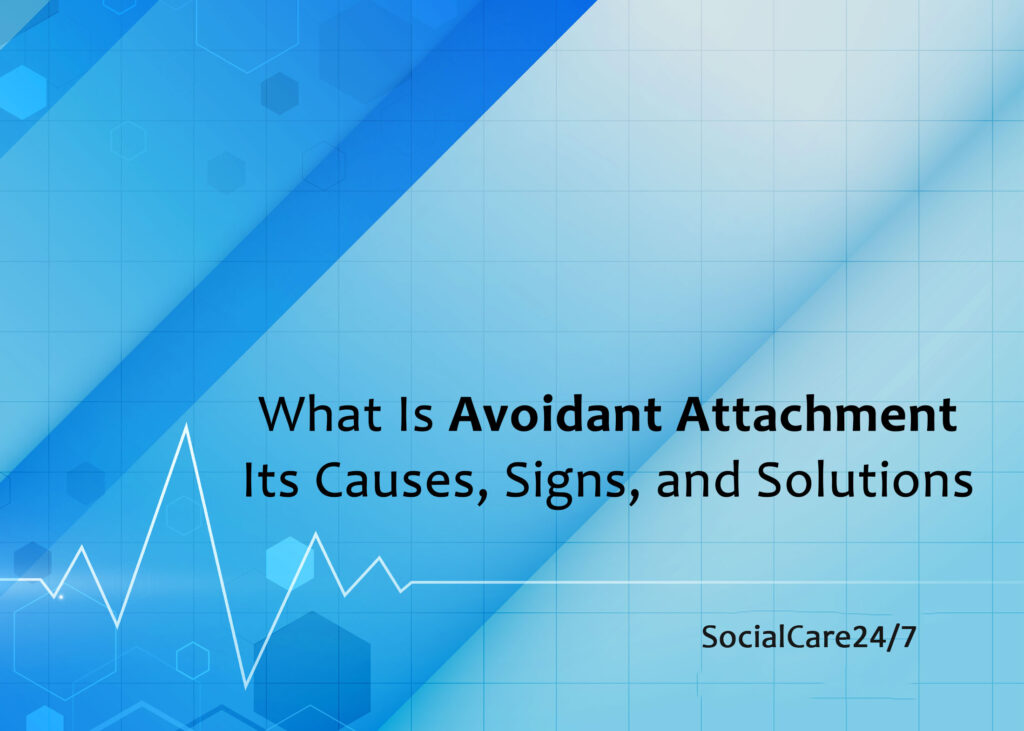Avoidant attachment is a psychological disease that affects interpersonal relationships. A child’s emotional needs not satisfied in childhood might make it challenging to build solid adult ties. Avoidant attachment disorder youngsters withdraw from others to cope with unresponsive caretakers.
These sentiments might hinder their sexual, bonding, and familial interactions as kids become older, making it hard to trust or depend on others. This pattern can bring lifelong mental anguish. Understanding avoidant attachment and how it operates might help people overcome their mental isolation.
Causes of Avoidant Attachment
- Unresponsive Caregivers: If a youngster’s parents or primary caretakers don’t respond to their cries or wants, they may learn to suppress their emotions. In the long term, this makes individuals feel emotionally powerful and makes them think asking for support is futile.
- Discouragement of Emotional Expression: Some parents advise their children not to cry or talk about their feelings. Some parents advise their children not to cry or talk about their feelings. Negative feedback might make kids think their emotional needs are a problem, making them more independent and emotionally detached.
- Lack of Emotional Availability: If a caretaker is emotionally unavailable due to worry, mental illness, or other issues, the kid may not get the love and support they need to trust and bond with them. Lack of mental support makes the child think their feelings are unimportant.
- Neglect or abuse: Emotional neglect or abuse can affect a child’s relationships. Growing up, kids learn to suppress their emotional demands to avoid additional pain. Physically, emotionally, or both, they may develop avoidant attachment due to this.
- Parental Stress or Illness: Parents with mental health concerns, long-term diseases, or high stress may struggle to provide consistent social assistance. The youngster may feel abandoned or neglected and retreat to cope when this happens.
Signs of Avoidant Attachment
- Emotional Disconnection: Avoidant attachment disorder sufferers lack emotional expression. Even when others talk about their feelings, they may appear cold or disconnected.
- Reluctance to Seek Help: Avoidant attachment includes a reluctance to ask for mental or physical aid. This condition may lead people to assume they can handle everything without support.
- Difficulty with Physical Closeness: Avoidant attachment may make touch and intimacy unpleasant. They may not want to embrace, kiss, or be near in any way that seems intimate.
- Fear of Dependency: Fearing rejection or harm, avoidant attachment disorder sufferers seldom depend on others. They may not want others to rely on them because they don’t want mental health responsibilities.
- Trouble with Commitment: Avoidant attachment can make love commitments difficult. They may worry that tight connections may hinder their independence and emotional expression.
- Dismissal of Emotional Needs: Avoidant attachment may downplay or neglect emotional demands. The person’s sentiments may not matter, or they may not require aid.
Treatments for Avoidant Attachment
To overcome avoidant attachment, you must confront and modify long-held attitudes and habits. Cognitive behavioral therapy (CBT) is essential to treatment since it works effectively. CBT lets individuals identify and change negative thinking habits. It helps people overcome the practice of keeping their emotions in by talking about them in a secure and encouraging environment. Cognitive behavioral therapy helps people become more open and vulnerable, which allows them to form more authentic bonds.
You can benefit from CBT and attachment-based treatment. This therapy investigates attachments and helps clients consider prior events that may have led to avoidance. Recalling these early encounters might influence how people feel about intimacy and trust. With expert therapy, avoidant attachment disorder sufferers can build more muscular attachments and happier relationships.
Preventing Avoidant Attachment
Stopping avoidant bonding starts with a secure emotional place for youngsters. Being present for their child and addressing their needs may make a significant impact. This requires more than simply providing food and shelter; it also means being present and aware of their feelings. When a child cries, you help them feel heard and supported by comforting and validating their feelings. Affection and warmth from parents can allow youngsters to form stable attachments. This prepares adults for successful connections.
Parents should also teach their children to express themselves. Kids learn to manage their emotions by witnessing caring people. Suppose parents are honest about their feelings and teach their kids appropriate ways to handle emotional issues. In that case, kids will learn how to express themselves—talking, spending time together, and loving one another no matter what can prevent avoidant attachment.
Conclusion
Avoidant attachment results from early emotional trauma or insensitivity. These people struggle with emotional intimacy, trust, and honesty, making it challenging to maintain good relationships throughout their lives. However, understanding avoidant attachment and its symptoms might help you identify effective treatments like cognitive behavioral therapy and attachment-based therapy.
Addressing one’s emotional tendencies may help people have safer, more enjoyable relationships. Create a secure, supportive environment to prevent avoidant attachment in youngsters. Help and remedies can help avoidant attachment sufferers overcome emotional isolation and improve relationships.
Source Link:
https://www.webmd.com/parenting/what-is-avoidant-attachment
https://www.medicalnewstoday.com/articles/avoidant-attachment#summary



